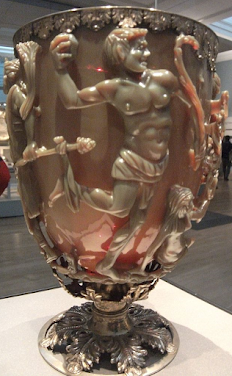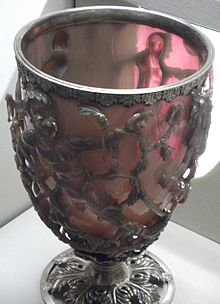 | While nanoparticles sound like a recent discovery, the tiny structures have been used for centuries. The Lycurgus cup, made by 4th century Roman artisans, features dichroic glass. The Lycurgus Cup, with gold and silver nanoparticles sprinkled throughout, produces a green appearance when light is shining on it from the front, and a red appearance when illuminated from behind. The cup was perhaps made in Alexandria or Rome about 290-325 AD. In 1958 Victor, Lord Rothschild sold the cup to the British Museum for £20,000. |
 | The cup is also a very rare example of a complete Roman cage-cup, or diatretum, where the glass has been painstakingly cut and ground back to leave only a decorative "cage" at the original surface-level. The cup features a composition with figures, showing the mythical King Lycurgus, who tried to kill Ambrosia, a follower of the god Dionysus (Bacchus to the Romans). She was transformed into a vine that twined around the enraged king and restrained him, eventually killing him. Dionysus and two followers are shown taunting the king. |
 | The process used to create the dichroic effect remains unclear, and it's likely that it wasn't well understood or controlled by the makers. |  |

No comments:
Post a Comment